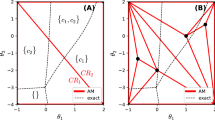Abstract
In this paper two enumerative algorithms for the Linear Complementarity Problems (LCP) are discussed. These procedures exploit the equivalence of theLCP into a nonconvex quadratic and a bilinear programs. It is shown that these algorithms are efficient for processing NP-hardLCPs associated with reformulations of the Knapsack problem and should be recommended to solve difficultLCPs.
Similar content being viewed by others
References
Al-Khayyal F. (1987). An implicit enumeration procedure for the general linear complementarity problem.Mathematical Programming Studies 31, 1–20.
Bialas W. and Karwan M. (1984). Two-level linear programming.Management Science 30, 1004–1020.
Chung S. (1989). NP-completeness of the linear complementarity problems.Journal of Optimization Theory and Applications 60, 393–399.
Conn A.R., Gould N-I., Orban D. and Toint Ph.L. (2000). A primal-dual trust-region algorithm for non-convex nonlinear programming.Mathematical Programming 87, 215–249.
Cottle R., Pang J. and Stone R. (1992).The linear complementarity problem. Academic Press.
Fernandes L., Friedlander A., Guedes M.C. and Júdice J. (2001). Solution of a general linear complementarity problem using smooth optimization and its application to bilinear programming andLCP, Applied Mathematics and Optimization 43, 1–19.
Floudas C. (2000).Deterministic global optimization: theory, methods and applications. Kluwer Academic Publishers.
Gay D.M., Overton M.L. and Wright M.H. (1998). A primal-dual interior-point method for nonconvex programming. In: Yuan Y. (ed.)Advances in Nonlinear Programming. Kluwer Academic Publishers, 31–56.
Horst R., Pardalos P. and Thoai N.V. (1995).Introduction to global optimization. Kluwer Academic Publishers.
IBM Corporation (1992). IBM optimization subroutine library guide and reference.IBM Systems Journal 31.
Júdice J. and Faustino A. (1988a). The solution of the linear bilevel programming problem by using the complementarity problem.Investigação Operational 8, 77–95.
Júdice J. and Faustino A. (1988b). An experimental investigation of enumerative methods for the linear complementarity problem.Computers and Operations Research 15, 417–426.
Júdice J. and Faustino A. (1991). A computational analysis of LCP methods for bilinear and concave quadratic programming.Computers and Operations Research 18, 645–654.
Júdice J., Fernandes L. and Lima A. (1996). On the solution of the monotone and nonmonotone linear complementarity problem by an infeasible interior point algorithm. In: Pillo G.D. and Giannessi F. (eds.),Nonlinear Optimization and Applications. Plenum Press, 213–227.
Júdice J. and Vicente L.N. (1994). On the solution and complexity of a generalized linear complementarity problem.Journal of Global Optimization 4, 415–424.
Kojima M., Megiddo N., Noma T. and Yoshise A. (1991).A unified approach to interior-point algorithms for linear complementarity problems. Lecture Notes in Computer Science 538, Springer-Verlag.
Konno H. (1976). A cutting-plane algorithm for solving bilinear programs.Mathematical Programming 11, 14–27.
Mangasarian O.L. (1995). The linear complementarity problem as a separable bilinear program.Journal of Global Optimization 6, 153–161.
Murty K. (1983).Linear programming. John Wiley.
Murty K. (1988).Linear complementarity, linear and nonlinear programming. Heldermann Verlag.
Murty K. and Júdice J. (1996). On the complexity of finding stationary points of nonconvex quadratic programming.Opsearch 33, 162–166.
Nocedal J. and Wright S. (1999).Numerical optimization, Springer Verlag.
Sherali H. and Adams W. (1999).A reformulation-linearization technique for solving discrete and continuous nonconvex problems. Kluwer Academic Publishers.
Sherali H., Krishnamurty R. and Al-Khayyal F. (1998). Enumeration approach for linear complementarity problems based on a reformulation-linearization technique.Journal of Optimization Theory and Applications 99, 481–507.
Vanderbei R.J. and Shanno D.F. (1999). An interior-point algorithm for nonconvex nonlinear programming.Computational Optimization and Applications 13, 231–252.
Wright S. (1997).Primal-dual interior-point methods. SIAM.
Author information
Authors and Affiliations
Additional information
Support for this author was provided by Instituto de Telecomunicações and byFCT under grant POCTI/35059/MAT/2000
Support for this author was provided byPRODEP under grant 4/5.3/PRODEP/00
Rights and permissions
About this article
Cite this article
Júdice, J.J., Faustino, A.M. & Ribeiro, I.M. On the solution of NP-hard linear complementarity problems. Top 10, 125–145 (2002). https://doi.org/10.1007/BF02578944
Received:
Accepted:
Issue Date:
DOI: https://doi.org/10.1007/BF02578944




